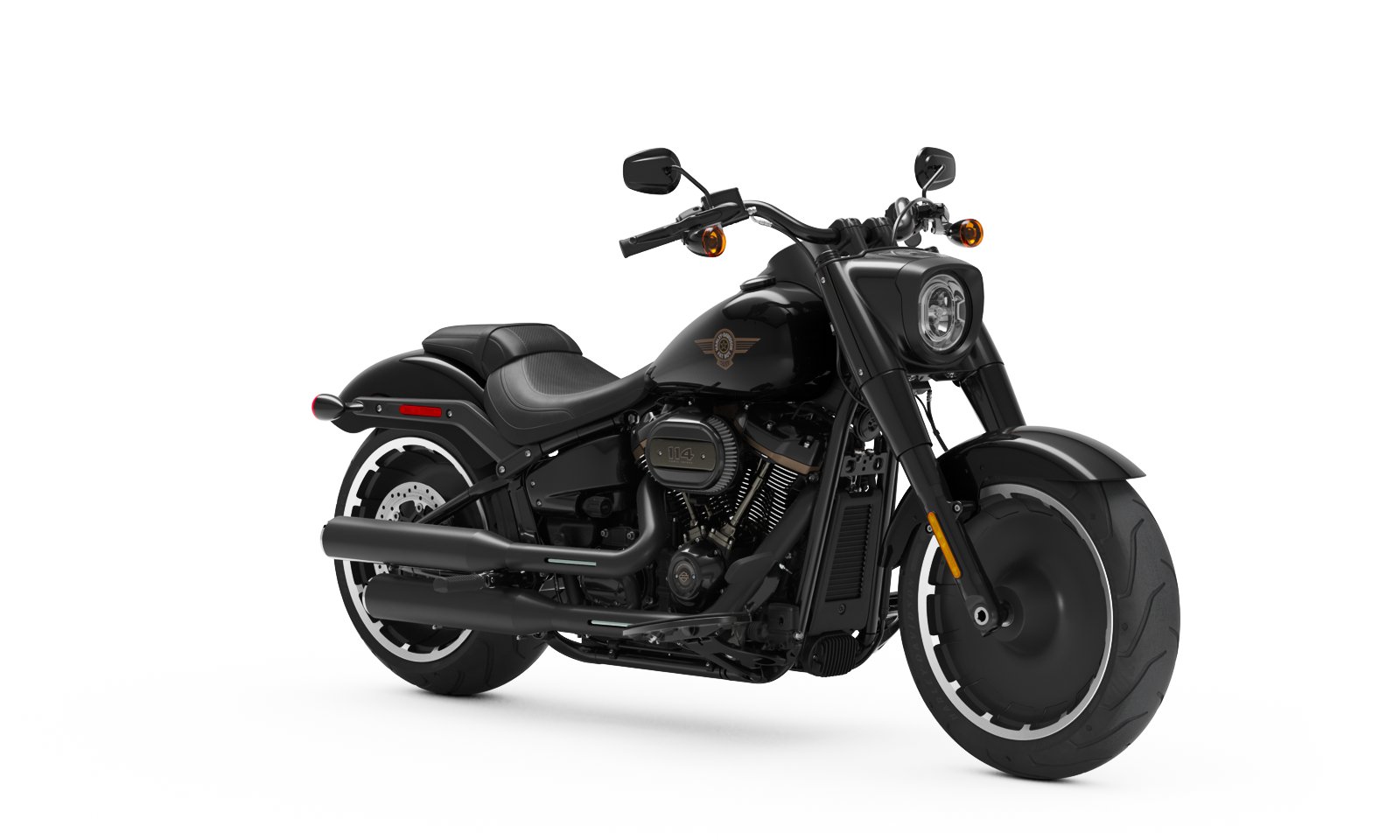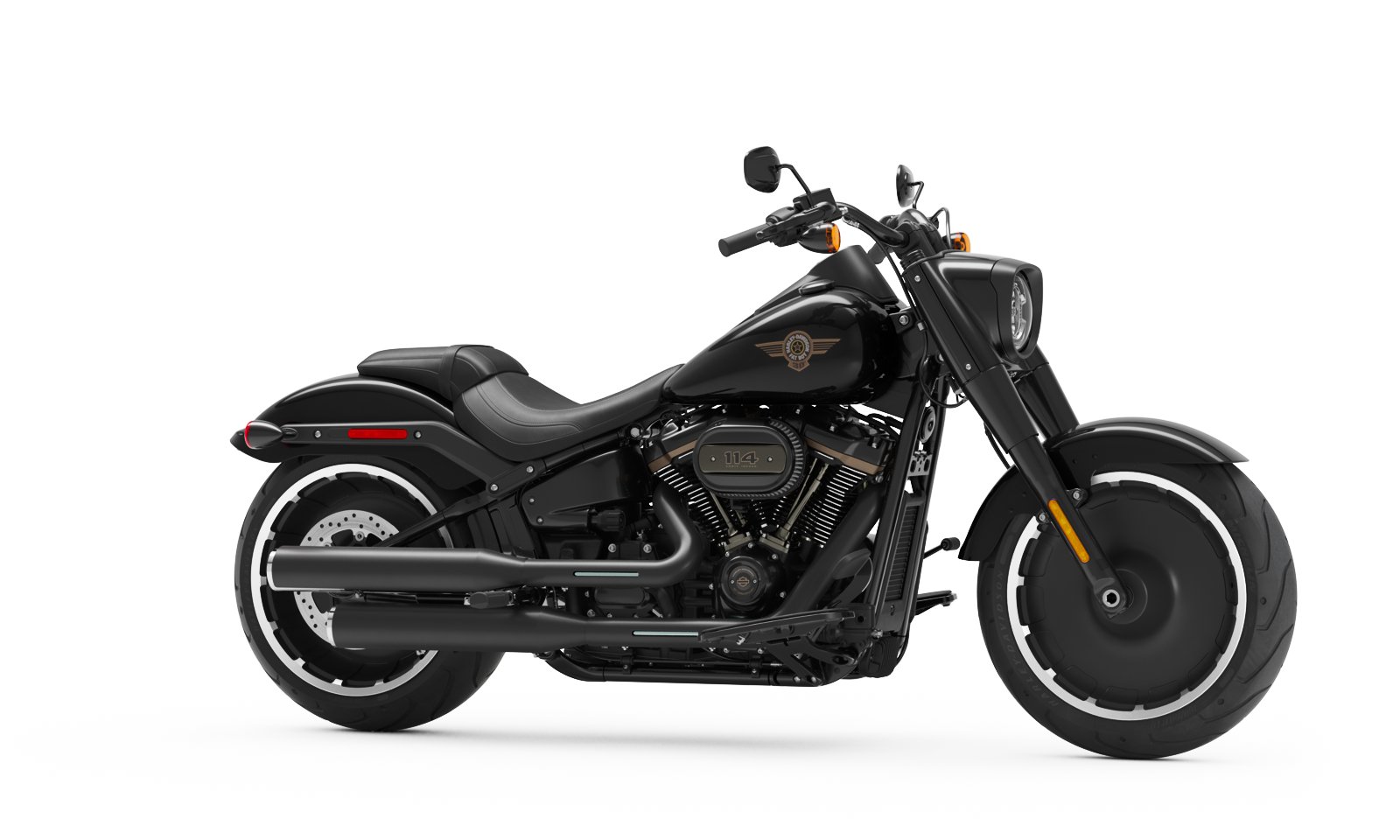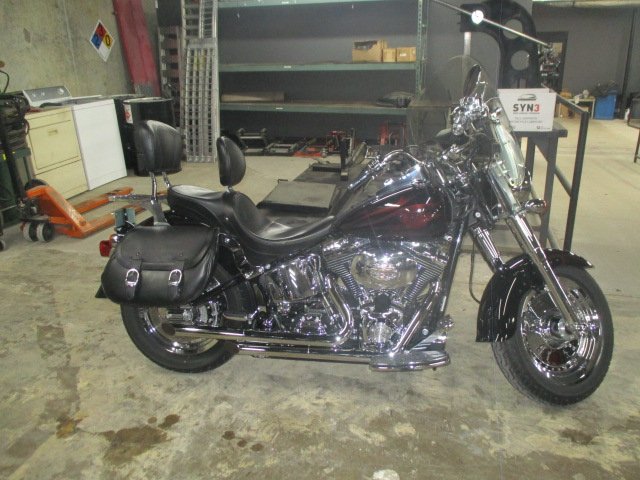| Manufacturer | Harley-Davidson |
|---|---|
| Production | Since 1990 |
| Class | Cruiser |
| Engine |
1,868 cc (114 cu in) |
| Transmission | Chain (Primary) / Belt (final drive) |
| Brakes | Disc/disc |
| Wheelbase | 1,636 mm (64.4 in) |

The Harley-Davidson Fat Boy, is a V-twinsoftailcruisermotorcycle with solid-cast disc wheels.[2] Designed by Willie G. Davidson and Louie Netz, Harley-Davidson built a prototype Fat Boy in Milwaukee for the Daytona Bike Week rally at Daytona Beach in 1988 and 1989.[3][4] Fat Boys produced from 1990-2017 are coded FLSTF, and FLFB (& FLFBS) from 2018.
– 2002 Harley-Davidson FLSTF-FLSTFI Fat Boy. MANUFACTURER SPECIFICATIONS. Manufacturer – Make – Model – Year: Harley-Davidson FLSTF – FLSTFI Fat Boy 2002 Motorcycle Style: Cruiser. ENGINE SPECS Engine Type: 1449 cc, 4-Stroke, Air Cooled, V-Twin Engine Bore and Stroke: 95.3 mm x 101.6 mm Valves 2 valves/cylinder. Racing track capabilities for the 2002 Harley-Davidson FLSTF Fat Boy: (42.4 out of 100) Click here for complete rating. You can also compare bikes. Pictures, trademarks and logos of third parties are the exclusive property of the respective owners.
The name is said to come from the bike's 'massive presence.”
History and development[edit]


The Fat Boy's frame is derived from the 1984 'Softail' which appears to have a rigid hardtail chassis but which in fact has a swinging arm with concealed springs that was originally designed in a Missouri garage in the 1970's by 'a mechanical engineer' named Bill Davis and later Patented in 1976.[5]Willie G the grandson of Harley-Davidson co-founder William A. Davidson originally turned down engineer Bill Davis' softail concept; but the company later relented, buying the rights and designing its own softail frame in-house.[6]
- After 1994, the exhaust was made seamless.
- In 1996 the master cylinder and switch gear were revised.
- In 1999 a new 1,450 cc (88 cu in) Twin Cam engine for the 2000 model year was used. This necessitated a bespoke engine variant and changes to the frame.
- In 2002 bullet-style indicators, alarm and immobilizer were added.[7]
- In 2005 a 15th Anniversary version was sold, with a 'Screamin' Eagle' engine, special paint and custom wheels.[7]
- In 2007 the displacement was increased to 1,584 cc (96.7 cu in)[7] and the transmission changed six speeds.[6]
- The 2010 'Fat Boy Lo' FLSTFB had the lowest ever Harley seat height.[2]
- In 2012 the Fat Boy received the new 1,690 cc (103 cu in) Twin Cam engine along with the rest of the softail range*

The 2018 Fat Boys have a redesigned softail frame with Showa front and rear suspension and new twin-counterbalanced Milwaukee-Eight engines. The two 2018 variants comprise:
- The FLFB 1,746 cc (107 cu in) with 109 lb⋅ft (148 N⋅m), and
- The FLFBS 1,868 cc (114 cu in) with 119 lb⋅ft (161 N⋅m)[8]
The 2018 Softail frame has a modified swingarm with a Showa rear monoshock suspension mounted beneath the seat (replacing earlier twin shocks). So as to provide a more comfortable and better controlled ride with improved handling, the front forks contain a Showa 'Dual Bending Valve' (SDBV),[9] a cartridge simulator using two valves to control compression and rebound damping, giving linear damping characteristics proportional to fork stroke speed. Harley-Davidson claims the 2018 chassis is stiffer and lighter than earlier Softail and Dyna platforms.[10] Further upgrades include an LED headlight and 18-inch “Lakester” rims, with wider 160mm front and 240mm rear rubber.[11][12]
For 2020, the Fat Boy is only available with the Milwaukee-Eight 114 engine. Harley-Davidson also produced a 30th Anniversary edition for 2020. [13]
It is one of Harley-Davidson's best selling models, and has appeared prominently in a number of TV shows and movies.[3] The Fat Boy earned a place in American pop culture after appearances in the movie Terminator 2: Judgment Day. One of the motorcycles used in Terminator 2 is displayed at the Harley-Davidson Museum. It appeared again in Terminator Genisys.[2][14][15][16]
References[edit]
- ^'MOTO USA'. Retrieved 25 October 2016.
- ^ abc'Harley Fat Boy History'. Harley-Davidson. Retrieved 25 October 2016.
- ^ ab'Fat Boy a Harley bestseller and Hollywood favorite for 25 years'. Milwaukee Wisconsin Journal Sentinel. Retrieved 28 October 2016.
- ^'Vehicle Profile:25 Years of the Harley-Davidson Fat Boy'. Harley-Davidson. Archived from the original on September 20, 2017. Retrieved May 28, 2017.
- ^Masker, Mark. 'Three decades of Softail'. Hot Bike. Bonnier Corporation. Retrieved May 21, 2019.
- ^ ab'Harley Fat Boy Launch'. Sump Magazine. Retrieved 25 October 2016.
- ^ abc'Harley Fat Boy Development'. Hogrides. Retrieved 25 October 2016.
- ^Cameron, Kevin (August 22, 2017). '2018 Harley-Davidson Softail Cruisers Tech and Development'. Cycle World. Retrieved September 17, 2017.
- ^SDBV image [1]
- ^'2018 Harley-Davidson Softail Cruiser Lineup'. Cycle World. 2017. Retrieved September 9, 2017.
- ^MacDonald, Sean (August 22, 2017). 'This Is The New 2018 Harley-Davidson Softail Fat Boy'. Cycle World. Retrieved July 9, 2018.
- ^MacDonald, Sean (August 22, 2017). 'This Is The New 2018 Harley-Davidson Softail Fat Boy'. Cycle World. Retrieved July 9, 2018.
- ^'2020 Harley-Davidson Fat Boy 30th Anniversary Unveiled'. UltimateMotorcycling.com. Ultimate Motorcycling. Retrieved 18 February 2020.
- ^''Terminator' Fat Boy preserved'. Motorbike Writer. Retrieved 26 October 2016.
- ^Barrett, Rick (July 22, 2015). 'Fat Boy a Harley bestseller and Hollywood favorite for 25 years'. The Milwaukee Journal Sentinel. Retrieved July 9, 2018.
- ^Hinton, TJ (January 12, 2018). 'Low Seat Height, Butt-Friendly Saddle, And A Smooth Ride'. Top Speed. Retrieved July 9, 2018.

2002 Harley Davidson Fatboy Tire Size Guide
Harley-Davidson FLSTF Fat Boy General Information | |
| Brand | Harley-Davidson |
| Model | Harley-Davidson FLSTF Fat Boy |
| Start year | 2002 |
| Year | 2002 |
| Category | Custom / cruiser |
| Factory Warranty (Years / miles) | - |
2002 Harley Davidson Fatboy Specifications
Harley-Davidson FLSTF Fat Boy Dimensions, Aerodynamics and weight | |
| Frame type | - |
| Seat details | - |
| Wheelbase | 1,630 mm (64.2 inches) |
| Length | 2,396 mm (94.3 inches) |
| Width | - |
| Height | - |
| Seat Height | - |
| Alternate Seat Height | - |
| Ground Clearance | 123 mm (4.8 inches) |
| Trail size | - |
| Wheels details | - |
| Front Tyres - Rims dimensions | - |
| Rear Tyres - Rims dimensions | - |
| Front brakes | Single disc |
| Rear brakes | Single disc |
| Front Brakes Dimensions - Disc Dimensions | 292 mm (11.5 inches) |
| Rear Brakes Dimensions - Disc Dimensions | 292 mm (11.5 inches) |
| Curb Weight (including fluids) | - |
| Dry Weight | 320.0 kg (705.5 pounds) |
| Front Percentage of Weight | - |
| Rear Percentage of Weight | - |
| Weight-Power Output Ratio : | - |
| Fuel Tank Capacity | 18.90 litres (4.99 gallons) |
| Reserve Fuel Capacity | 1.90 litres (0.50 gallons) |
| Carrying Details and Capacity | - |
| Front Suspension | - |
| Front Suspension Travel | - |
| Rear Suspension | - |
| Rear Suspension Travel | - |
